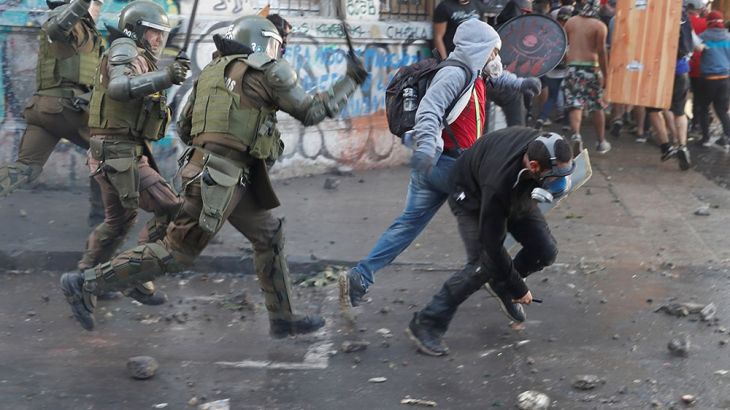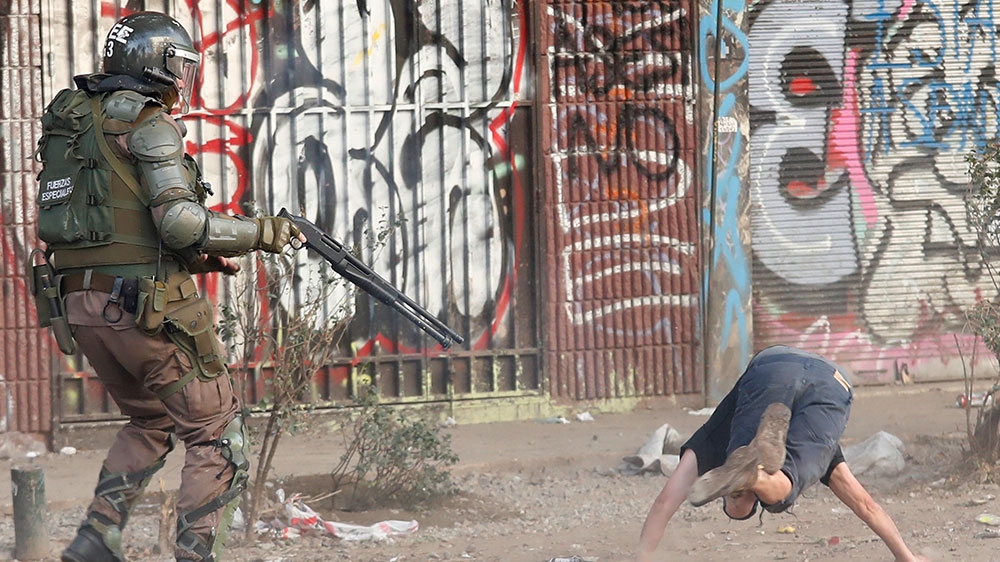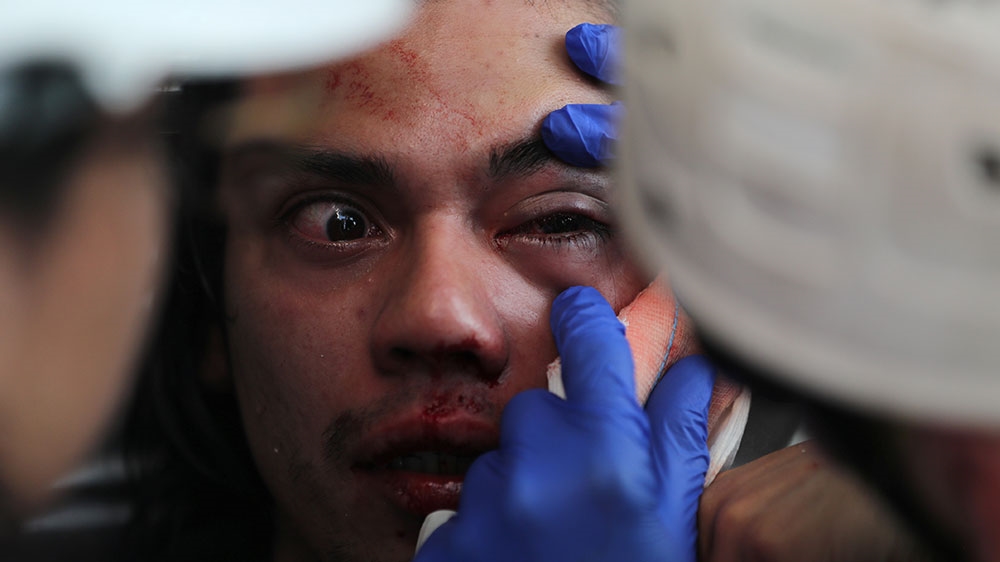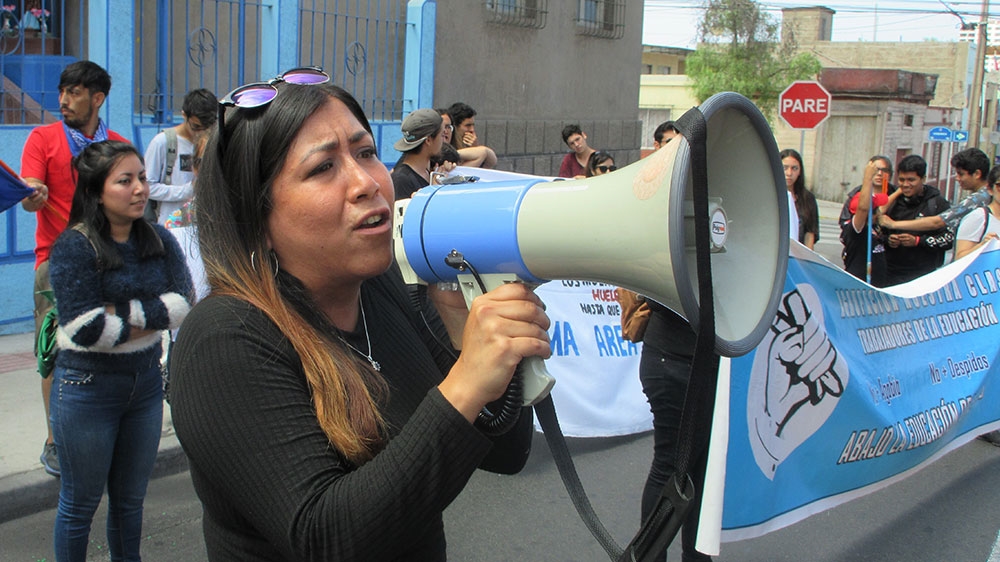Chile security forces ‘intentionally’ injure protesters: Amnesty
The international rights group says rights abuses against protesters ‘are not isolated acts’.

Antofagasta, Chile – Chilean security forces have engaged in widespread and indiscriminate attacks against protesters over the last month, Amnesty International said on Thursday.
A team from the UK-based rights organisation visited Chile this week to document and analyse alleged human rights violations in the context of the crisis sparked by continuing mass demonstrations against inequality and injustice.
Keep reading
list of 3 itemsChile opposition files ‘constitutional accusation’ against Pinera
Chile’s Pinera vows action over security forces abuses
“These are not isolated acts,” Erika Guevara-Rosas, Americas director at Amnesty International, said in a news conference in Santiago.
“The intention of the Chilean security forces is clear: to injure demonstrators in order to discourage protest,” she said in a separate statement.
Prosecutors in Chile have said they are investigating 26 deaths that occurred during the unrest, including four people killed by military forces and one by Carabinero police officers. Amnesty International focused on 23 emblematic cases of killings, injuries and alleged torture other abuses that are indicative of broader patterns, said Guevara-Rosas.
Chile’s National Human Rights Institute has documented thousands of cases of alleged abuse through on-site visits to police stations, hospitals and protests. Institute personnel have verified more than 6,000 detentions and more than 2,000 hospitalisations, as well as cases of killings, torture, sexual violence, and other abuses.
“The numbers do not lie,” said Guevara-Rosas at Thursday’s news conference.

Prosecutors in Chile have received approximately 1,100 formal reports of torture and 70 reports of abuses of a sexual nature, including violence against lesbian, gay and transgender Chileans and rape, the Amnesty International representatives noted.
In a statement on Sunday night, Chilean President Sebastian Pinera acknowledged there were cases of abuses by security forces and instances when human rights were not respected.
“In some cases, protocols were not respected. There was excessive use of force. Abuses or crimes were committed,” he said, adding that the government is committed to investigating and prosecuting those cases.
Amnesty International urged Chilean authorities to investigate high-level officials to determine who ordered or tolerated abuses, instead of limiting prosecution to individual military and police officers. There is a policy of punishment instead of safeguarding the right to protest and freedom of expression, said Guevara-Rosas.
“Carabineros have carried out generalised attacks against the population,” Guevara-Rosas she added. “There is a consistent pattern.”
Eye injuries
The rights group also expressed alarm at the number of severe eye injuries, including loss of vision, which continues to rise. There are now 287 documented cases, primarily caused by projectiles fired by police, according to Chile’s national medical association.
“That number is truly abhorrent,” Pilar Sanmartin, a crisis researcher for Amnesty International, said at Thursday’s news conference.
Round rubber-and-metal projectiles known locally as “balines” caused most of the eye injuries. Controversy over the use increased earlier this week when the University of Chile published a study concluding the projectiles only contain 20 percent rubber and 80 percent other components, including lead.
Following the study and ensuing outcry, Carabineros police director Mario Rozas announced on Tuesday their suspension pending a technical study. Their use will only be permitted in extreme situations of imminent risk of death of a police officer or civilian, he said.

The components of the projectiles are secondary to the manner in which they have been used, said Sanmartin. Police have caused eye injuries because they are firing projectiles indiscriminately at eye level instead of following requirements to aim non-lethal rounds at legs, she said.
There are also documented cases of police violence against clearly identified medical personnel, journalists, and human rights observers, the Amnesty International representatives noted. In one case, an observer from the National Human Rights Institute, a state institution, was hit by six of the contentious projectiles.

In Antofagasta, a city 1,400km (860 miles) north of Santiago, an all-volunteer commission of doctors, nurses, paramedics and other medical personnel provides first aid to protesters inside the local headquarters of the national teacher’s association.
“We have been quite besieged by Carabineros,” Patricia Romo, president of the association’s local chapter in Antofagasta, told Al Jazeera.
“They tried to enter three times, and later detained a protester inside,” she said, adding that a court in Antofagasta has since issued a protective measure, ordering police to stay out of the teacher’s association building.
A mission from the Inter-American Commission on Human Rights has also been in the country this week, gathering testimonies and information.
“The important thing is to verify whether these abuses responded to a kind of pattern, what its scale and scope were, and what should be done,” Paulo Abrao, the body’s secretary-general, said in a statement on Wednesday.
A team from the United Nations Office of the High Commissioner for Human Rights has been in the country for three weeks and will wrap up its visit Friday.